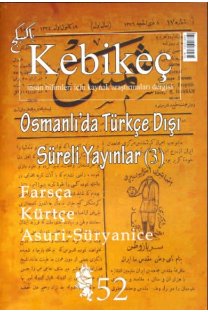Arap milliyetçiliğinindoğuşunu yeniden düşünmek
Bu makalede Mahmud Haddad Birinci Dünya Savaşı öncesinde Suriye'de Arap milliyetçiliğinin menşeini ikili bir tez ekseninde tartışmayı denemektedir. Birinci tez geleneksel Arap eliti arasında ihtilafa işaret eden toplumsal bir yaklaşıma dayanmaktadır. Birinci tezin ikinci kısmı ise ideolojiktir. Bu tez Arap milliyetçiliğinin Avrupa siyasî akımlarını yayan Lübnanlı Hıristiyan Arapların eseri olduğu fikrini ve ayrıca Birinci Dünya Savaşı öncesinde Jön Türk iktidarı süresinde Arap milliyetçilerinin özel gündemini reddetmektedir. Arapçılarm iktidardaki İttihat ve Terakki Cemiyetini Türkleştirme politikaları için suçlayacak hiç bir sebebi yoktu ve bu politikalar 1908'de İttihat ve Terakki Cemiyeti iktidara gelmeden önce zaten uygulanmaktaydı. Jön Türk dönemi boyunca Arabist sözcüler merkezi iktidarı Türkleştirme politikası takip etmekle suçladılar. Ayrıca Haddad çalışmasında "bir millet", "bir devlet" politikasının tersine, Arapçılarm "farklı milletler", "bir devlet" politikasındaki ısrarlarına da vurgu yapmaktadır. İkinci tez Jön Türklerin altında Arap hareketinin sadece geleneksel bir grubun aracı olmadığını aynı zamanda farklı bir toplumsal tabanı temsil eden grupların ve yeni güçlerin Arap siyasetine girişi için bir araç olduğu düşüncesini ileri sürmektedir. Haddad'a göre bu tartışmada sadece kültürel, sosyal ve siyasî konular arasında bir ayrım yapılarak netlik sağlanabilir. Bu çalışmada bahsi geçen erken Arap milliyetçiliği olsa da, bu her üç alanda aktif, çok yönlü bir harekettir.
Re-thinking the birth of Arab nationalism
In his article Mahmud Haddad discusses the origins of Arab nationalism in Syria before World War I around a twofold thesis. The first is a social explanation, pointing out that it was a traditional intra-Arab elite conflict. The second is ideological.However this thesis rejects the idea that Arab nationalism was the creation of Lebanese Christian Arabs spreading European political doctrines and also the Arab nationalists' specific agenda during the Young Turk era before World War I. The Arabists had no grounds for accusing the ruling Committee of Union and Progress of turkification policies and these policies had already been practiced before Young Turks' coming to power in 1908. Arabist spokesmen during the Young Turk era have accused the central government of pursuing a policy of turkification. Haddad also emphasizes that the Arabists insisted on a policy of several nations-one state in contrast to the notion of one nation-one state. Second thesis advances the opinion that the Arab movement under the Young Turks was not the instrument of one traditional faction exclusively but also a vehicle for the introduction into Arab politics of new forces and of groups, representing a different social base. To Haddad, clarity in this debate can only be achieved through distinguishing among cultural, social, and political concerns. Although what is mentioned in this study was the early Arab nationalism, it was a multidimensional movement that was active in all three areas.
- ISSN: 1300-2864
- Yayın Aralığı: Yılda 2 Sayı
- Başlangıç: 1995
- Yayıncı: Mehtap Yüksel
Sayıdaki Diğer Makaleler
Bir siyasi-idari kurum olarak osmanlı'da Cami
Tarsus basın Tarihi üzerine bir not Sicil ve Ticaret Haberleri Gazetesi
Yoldan uzak kalmak: 19. yüzyılda Gümüşhane'de ''yol kavgası''
Arap milliyetçiliğinindoğuşunu yeniden düşünmek
Güvercin uçuverdi bir tutku olarak Ankara ve Urfa'da Güvercin yetiştiriciliği ve kültürü
Prof. Dr. Hikmet Ahmet Birand bibliyografyası için bir deneme
Hanımlara mahsus milliyetçilik: Fatma Aliye ve Erken milliyetçi stratejiler
